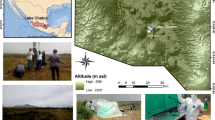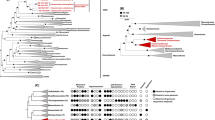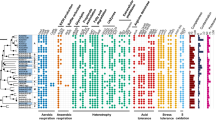Abstract
We have applied a global analytical approach to uncultured Archaea that for the first time reveals well-defined community patterns along broad environmental gradients and habitat types. Phylogenetic patterns and the environmental factors governing the creation and maintenance of these patterns were analyzed for c. 2000 archaeal 16S rRNA gene sequences from 67 globally distributed studies. The sequences were dereplicated at 97% identity, grouped into seven habitat types, and analyzed with both Unifrac (to explore shared phylogenetic history) and multivariate regression tree (that considers the relative abundance of the lineages or taxa) approaches. Both phylogenetic and taxon-based approaches showed salinity and not temperature as one of the principal driving forces at the global scale. Hydrothermal vents and planktonic freshwater habitats emerged as the largest reservoirs of archaeal diversity and consequently are promising environments for the discovery of new archaeal lineages. Conversely, soils were more phylogenetically clustered and archaeal diversity was the result of a high number of closely related phylotypes rather than different lineages. Applying the ecological concept of ‘indicator species’, we detected up to 13 indicator archaeal lineages for the seven habitats prospected. Some of these lineages (that is, hypersaline MSBL1, marine sediment FCG1 and freshwater plSA1), for which ecological importance has remained unseen to date, deserve further attention as they represent potential key archaeal groups in terms of distribution and ecological processes. Hydrothermal vents held the highest number of indicator lineages, suggesting it would be the earliest habitat colonized by Archaea. Overall, our approach provided ecological support for the often arbitrary nomenclature within uncultured Archaea, as well as phylogeographical clues on key ecological and evolutionary aspects of archaeal biology.
Similar content being viewed by others
Log in or create a free account to read this content
Gain free access to this article, as well as selected content from this journal and more on nature.com
or
References
Auguet JC, Casamayor EO . (2008). A hotspot for cold Crenarchaeota in the neuston of high mountain lakes. Environ Microbiol 10: 1080–1086.
Bintrim SB, Donohue TJ, Handelsman J, Roberts GP, Goodman RM . (1997). Molecular phylogeny of archaea from soil. Proc Natl Acad Sci USA 94: 277–282.
Brochier-Armanet C, Boussau B, Gribaldo S, Forterre P . (2008). Mesophilic crenarchaeota: proposal for a third archaeal phylum, the Thaumarchaeota. Nature Rev Microbiol 6: 245–252.
Casamayor EO, Borrego CM . (2009). Archaea in inland waters. In: Likens G (ed). Encyclopedia of Inland Waters, Vol. 3. Academic Press, Elsevier: Oxford, UK, pp 167–181.
Chaban B, Ng SYM, Jarrell KF . (2006). Archaeal habitats—from the extreme to the ordinary. J Can Microbiol 52: 73–116.
De'Ath G . (2002). Multivariate regression trees: a new technique for modeling species-environment relationships. Ecology 83: 1105–1117.
de la Torre J, Walker CB, Ingalls AE, Konneke M, Stahl DA . (2008). Cultivation of a thermophilic ammonia oxidizing archaeon synthesizing crenarchaeol. Environ Microbiol 10: 810–818.
DeLong E . (1992). Archaea in coastal marine environments. Proc Natl Acad Sci USA 89: 5685–5689.
DeLong EF . (1998). Everything in moderation: Archaea as ‘non-extremophiles’. Curr Opin Gen Dev 8: 649–654.
DeSantis TZ, Hugenholtz P, Larsen N, Rojas M, Brodie EL, Keller K et al. (2006). Greengenes, a chimera-checked 16S rRNA gene database and workbench compatible with ARB. Appl Environ Microbiol 72: 5069–5072.
Dufrene M, Legendre P . (1997). Species assemblages and indicator species: the need for a flexible asymmetrical approach. Ecol Monogr 67: 345–366.
Faith DP . (1992). Conservation evaluation and phylogenetic diversity. Biol Conserv 61: 1–10.
Field D, Garrity G, Gray T, Morrison N, Selengut J, Sterk P et al. (2008). The minimum information about a genome sequence (MIGS) specification. Nat Biotech 26: 541–547.
Francis CA, Beman JM, Kuypers MMM . (2007). New processes and players in the nitrogen cycle: the microbial ecology of anaerobic and archaeal ammonia oxidation. ISME J 1: 19–27.
Fuhrman JA, McCallum K, Davis AA . (1992). Novel major archaebacterial group from marine plankton. Nature 356: 148–149.
Gasol JM, Casamayor EO, Join I, Garde K, Gustavson K, Benlloch S et al. (2004). Control of heterotrophic prokaryotic abundance and growth rate in hypersaline planktonic environments. Aquat Microb Ecol 34: 193–206.
Helmus MR, Bland TJ, Williams CK, Ives AR . (2007). Phylogenetic measures of biodiversity. Am Nat 169: E68–E83.
Kembel S, Ackerly D, Blomberg S, Cowan P, Helmus M, Webb C . (2008). Picante: tools for integrating phylogenies and ecology. Version 0 4 0, http://picante.r-forge.r-project.org/.
Llirós M, Casamayor EO, Borrego CM . (2008). High archaeal richness in the water column of a freshwater sulphurous karstic lake along an inter-annual study. FEMS Microbiol Ecology 66: 331–342.
Lozupone C, Hamady M, Knight R . (2006). UniFrac—an online tool for comparing microbial community diversity in a phylogenetic context. BMC Bioinformatics 7.
Lozupone CA, Knight R . (2007). Global patterns in bacterial diversity. Proc Natl Acad Sci USA 104: 11436–11440.
Ludwig W, Strunk O, Westram R, Richter L, Meier H, Yadhukumar et al. (2004). ARB: a software environment for sequence data. Nucl Acids Res 32: 1363–1371.
McArdle B . (2001). Fitting multivariate models to community data: a comment on distance-based redundancy analysis. Ecology 82: 290–297.
Ochsenreiter T, Selezi D, Quaiser A, Bonch-Osmolovskaya L, Schleper C . (2003). Diversity and abundance of Crenarchaeota in terrestrial habitats studied by 16S RNA surveys and real time PCR. Environ Microbiol 5: 787–797.
Oksanen J, Kindt R, Legendre P, O'hara B, Simpson GL, Stevens MHH . (2008). Vegan: community ecology package. version 1 11 14, http://vegan.r-forge.r-project.org.
Ramette A, Tiedje JM . (2007). Biogeography: an emerging cornerstone for understanding prokaryotic diversity, ecology, and evolution. Microb Ecol 53: 197–207.
Reche I, Pulido-Villena E, Morales-Baquero R, Casamayor EO . (2005). Does ecosystem size determine aquatic bacterial richness? Ecology 86: 1715–1722.
Reche I, Pulido-Villena E, Morales-Baquero R, Casamayor EO . (2007). Does ecosystem size determine aquatic bacteria richness? Reply. Ecology 88: 253–255.
Robertson CE, Harris JK, Spear JR, Pace NR . (2005). Phylogenetic diversity and ecology of environmental Archaea. Curr Opin Microbiol 8: 638–642.
Schleper C . (2007). Diversity of uncultivated Archaea: perspectives from microbial ecology and metagenomics. In: Garret RA and Klenk HP (eds). Archaea: Evolution, Physiology and Molecular Biology. Blackwell Publishing: Oxford, UK, pp 39–53.
Schleper C, Jurgens G, Jonuscheit M . (2005). Genomic studies of uncultivated archaea. Nature Rev Microbiol 3: 479–488.
Schloss PD, Handelsman J . (2005). Introducing DOTUR, a computer program for defining operational taxonomic units and estimating species richness. Appl Environ Microbiol 71: 1501–1506.
Segerer AH, Burggraf S, Fiala G, Huber G, Huber R, Pley U et al. (1993). Life in hot springs and hydrothermal vents. Orig Life Evol Biosph, pp 77–90.
Shaw A . (2008). It's all relative: ranking the diversity of aquatic bacterial communities. Environ Microbiol 10: 2200–2210.
Sloan WT, Lunn M, Woodcock S, Head IM, Nee S, Curtis TP . (2006). Quantifying the roles of immigration and chance in shaping prokaryote community structure. Environ Microbiol 8: 732–740.
Torsvik V, Øvreås L . (2002). Microbial diversity and function in soil: from genes to ecosystems. Curr Opin Microbiol 5: 240–245.
van der Wielen P . (2005). The enigma of prokaryotic life in deep hypersaline anoxic basins. Science 307: 121–123.
von Mering C, Hugenholtz P, Raes J, Tringe SG, Doerks T, Jensen LJ et al. (2007). Quantitative phylogenetic assessment of microbial communities in diverse environments. Science 315: 1126–1130.
Acknowledgements
We are thankful to all the authors who provided valuable data for this work. We also acknowledge anonymous reviewers for valuable feedbacks and constructive comments. This research was supported by grant CRENYC CGL2006-12058 to EOC from the Spanish Ministerio de Educación y Ciencia (MEC), and CONSOLIDER-INGENIO 2010 project GRACCIE CSD2007-00004. JCA benefits from a Juan de la Cierva-MEC postdoctoral fellow, and AB is supported by an FPU-MEC predoctoral scholarship.
Author information
Authors and Affiliations
Corresponding author
Additional information
Supplementary Information accompanies the paper on The ISME Journal website (http://www.nature.com/ismej)
Supplementary information
Rights and permissions
About this article
Cite this article
Auguet, JC., Barberan, A. & Casamayor, E. Global ecological patterns in uncultured Archaea. ISME J 4, 182–190 (2010). https://doi.org/10.1038/ismej.2009.109
Received:
Revised:
Accepted:
Published:
Issue date:
DOI: https://doi.org/10.1038/ismej.2009.109
Keywords
This article is cited by
-
Thrive or survive: prokaryotic life in hypersaline soils
Environmental Microbiome (2023)
-
Insights on the particle-attached riverine archaeal community shifts linked to seasons and to multipollution during a Mediterranean extreme storm event
Environmental Science and Pollution Research (2023)
-
High Microeukaryotic Diversity in the Cold-Seep Sediment
Microbial Ecology (2023)
-
Quantitative Amplicon Sequencing Is Necessary to Identify Differential Taxa and Correlated Taxa Where Population Sizes Differ
Microbial Ecology (2023)
-
Community structure and activity potentials of archaeal communities in hadal sediments of the Mariana and Mussau trenches
Marine Life Science & Technology (2022)



